Reading Topic:
Deep Reinforcement Learning
KAUST-IVUL-July 20-2017
Guohao Li
lightaime@gmail.com
Deep Reinforcement Learning
- Q-Learning Methods
- Actor-Critic Methods
Deep Reinforcement Learning
- Q-Learning Methods
- Actor-Critic Methods
Q learning Methods
- Deep Q-network (Dec, 2013)
- Double DQN (Dec, 2015)
- Prioritized replay (Feb, 2016)
- Dueling network (Apr, 2016)
- Bootstrapped DQN (Jul, 2016)
Q learning Methods
- Deep Q-network (Dec, 2013)
- Double DQN (Dec, 2015)
- Prioritized replay (Feb, 2016)
- Dueling network (Apr, 2016)
- Bootstrapped DQN (Jul, 2016)
DQN (Dec 2013)
Deepmind proposed the first deep learning model to successfully learn control policies directly from high-dimensional sensory input using reinforcement learning
- raw pixels
- no hand-crafted features
- using CNN and MLP to approximate action-value function (Q function)
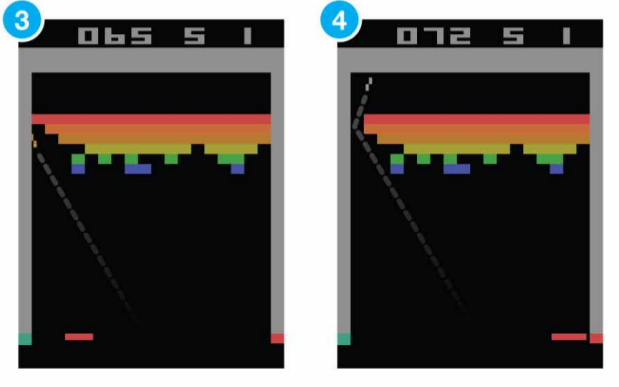
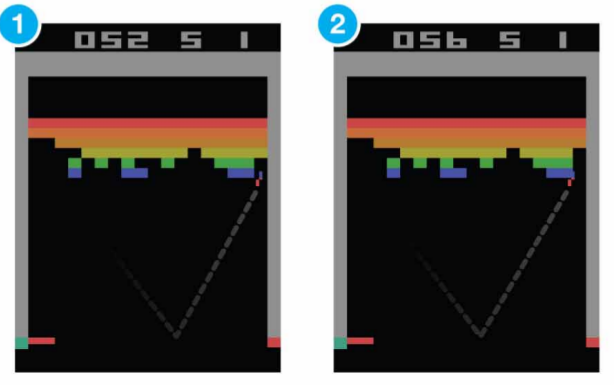
DQN (Dec 2013)
Neural Network Architecture
- input raw pixels
- using 3 CNN layers and 2 MLPs to approximate Q function
- output Q(s, a; θ)
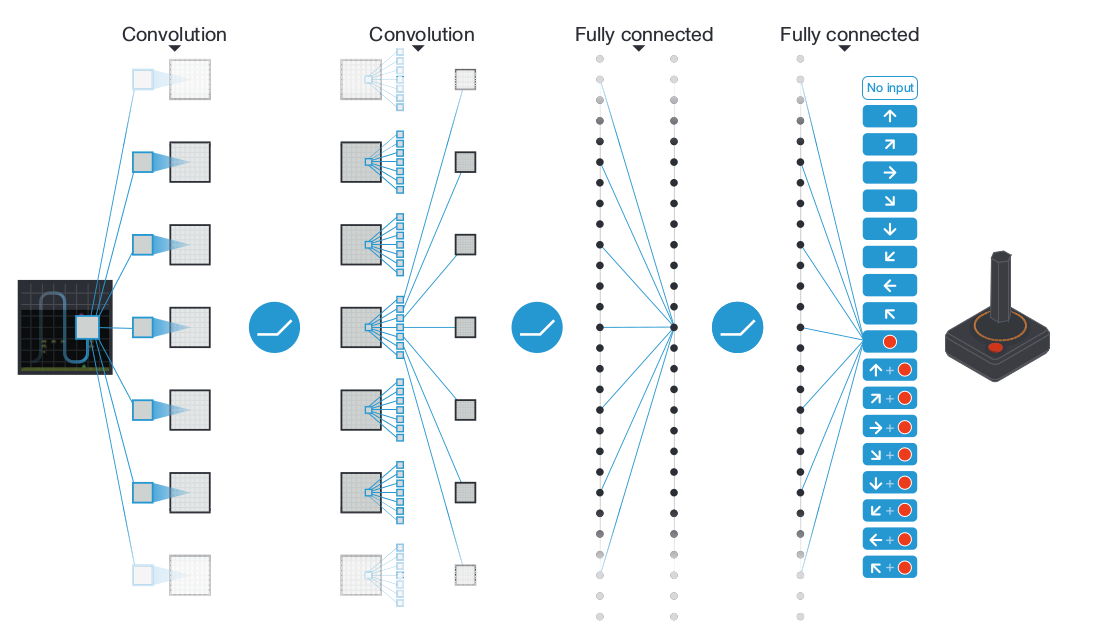
DQN (Dec 2013)
Algorithm Diagram (Nature 2015)
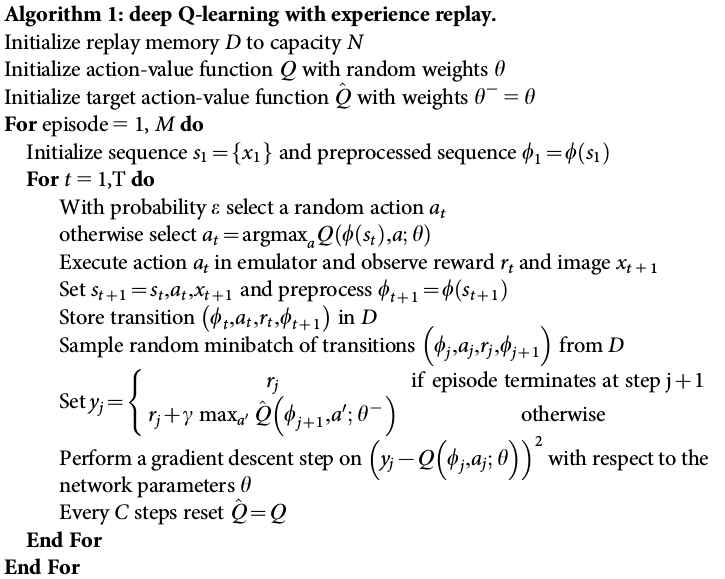
DQN (Dec 2013)
3 Tricks
experience replay
- greater data efficiency
- break correlations in data
target Q-network
- a separate network for generating target term
- more stable, prevent oscillations and divergence
clip the temporal diffierence error term
- adaptively to sensible range
- robust gradients
DQN (Dec 2013)
experience replay
- greater data efficiency
- break correlations in data

collecting experiences into replay memory and sample a min-batch to perform gradient descent to update


DQN (Dec 2013)
target Q-network
- a separate network for generating target term
- more stable, prevent oscillations and divergence

DQN (Dec 2013)
clip the temporal diffierence error term
- adaptively to sensible range
- robust gradients

clipping the error term to be between -1 and 1 responds to using |x| loss function for errors outside of the (-1, 1)
DQN (Dec 2013)
Result
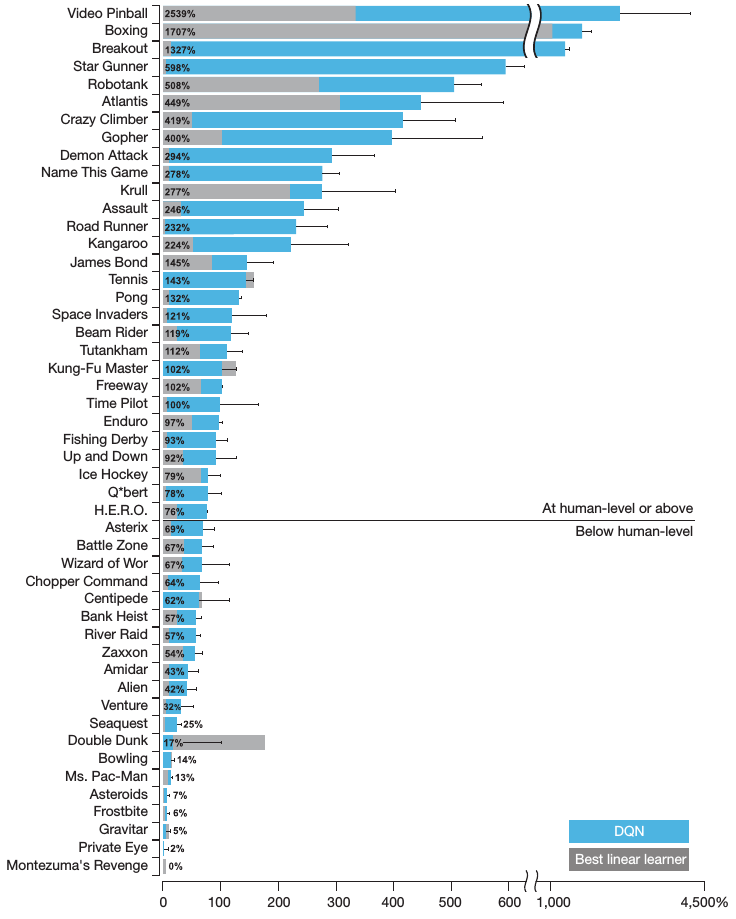
perform at a level that is broadly comparable with or superior to a professional human games tester in marjority of games
DQN (Dec 2013)
Result

Q learning Methods
Deep Q-network (Dec, 2013)- Double DQN (Dec, 2015)
- Prioritized replay (Feb, 2016)
- Dueling network (Apr, 2016)
- Bootstrapped DQN (Jul, 2016)
Double DQN (Dec 2015)
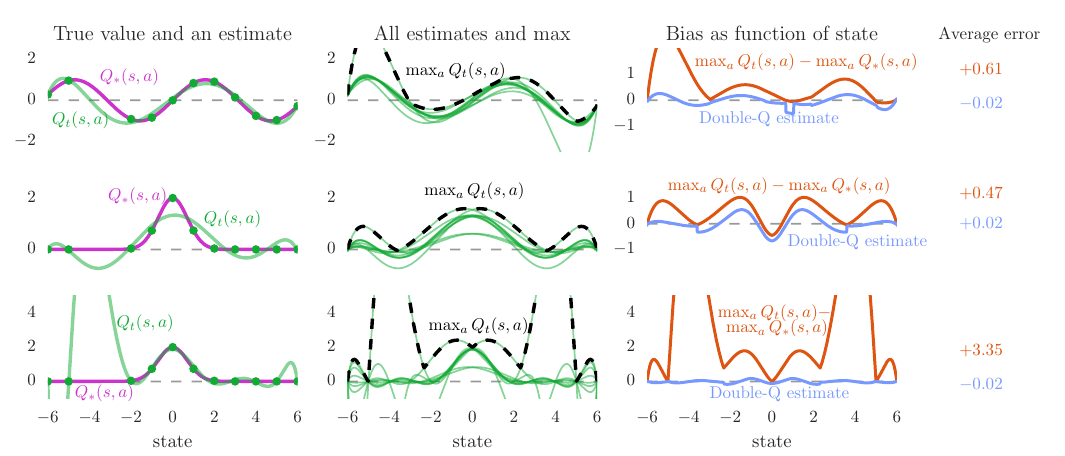
Double-Q reduce overestimations during learning
They generalized the Double Q-learning algorithm from tabular setting to arbitrary function approximation. This method yields more accurate value estimates and higher scores.
Double DQN (Dec 2015)
Maximization Bias and Double Q-Learning

Max operator induces maximization bias. Double Q-learning learns two independent estimates to maximize action and estimate action separately.

Double DQN (Dec 2015)
Double Q-Learning in tabular setting
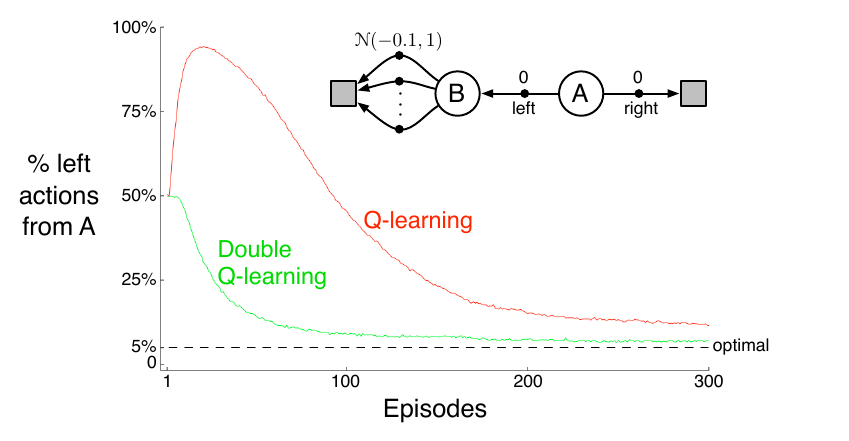
comparison of Q-learning and Double Q-learning
Double DQN (Dec 2015)
Double Q-Learning Network



generalize the Double Q-learning algorithm from tabular setting to DQN
using
target
Q-Network
to
estimate
Q learning Methods
Deep Q-network (Dec, 2013)Double DQN (Dec, 2015)- Prioritized replay (Feb, 2016)
- Dueling network (Apr, 2016)
- Bootstrapped DQN (Jul, 2016)
Prioritised replay (Feb 2016)
DQN and Double DQN simply replay transitions at the same frequency regardless of their significance. In this paper they proposed a framework for prioritizing experience by TD error.

mini-batch samples: i ~ uniform(i)

mini-batch samples: i ~ P(i)
Prioritised replay (Feb 2016)
Algorithm

Q learning Methods
Deep Q-network (Dec, 2013)Double DQN (Dec, 2015)Prioritized replay (Feb, 2016)- Dueling network (Apr, 2016)
- Bootstrapped DQN (Jul, 2016)
Dueling Network (Apr 2016)
They proposed an architecture that consists of two streams that represent the value(action independent) and advantage functions.


Dueling Network (Apr 2016)
Intuitively, the dueling architecture can learn which states are (or are not) valuable, without having to learn the effect of each action for each state.

value and advantage saliency maps
Dueling Network (Apr 2016)



The equation above is unidentifiable in the sense that the given Q we cannot recover V and A uniquely.
To address this issue of identifiability, they force the advantage function estimator to have zero advantage at the chosen action by following implementation.
or
Q learning Methods
Deep Q-network (Dec, 2013)Double DQN (Dec, 2015)Prioritized replay (Feb, 2016)Dueling network (Apr, 2016)- Bootstrapped DQN (Jul, 2016)
Bootstrapped DQN (Jul 2016)
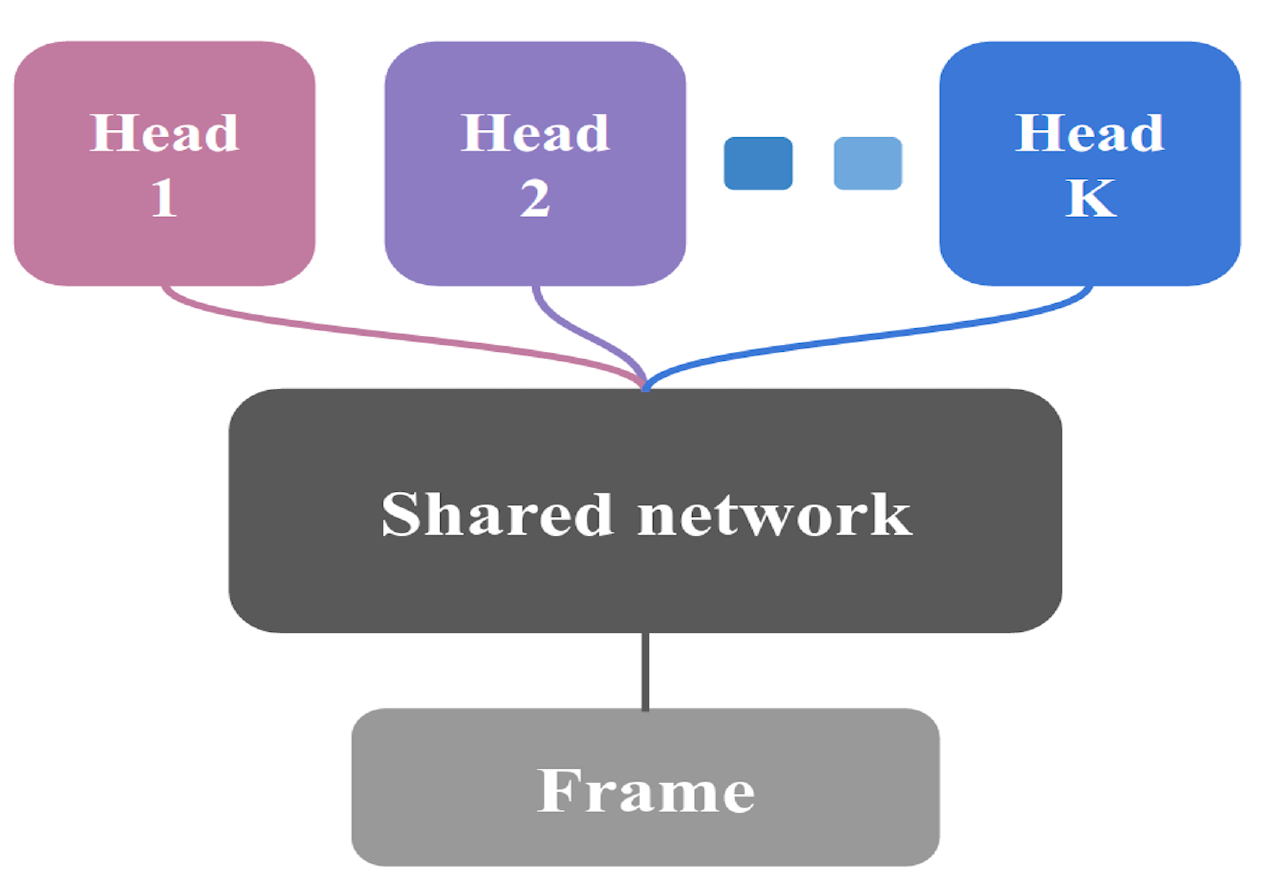
They proposed an efficient and scalable exploration method for generating bootstrap samples from a large and deep neural network. The network consists of a shared architecture with K bootstrapped "heads" branching off independently.
Bootstrapped DQN (Jul 2016)
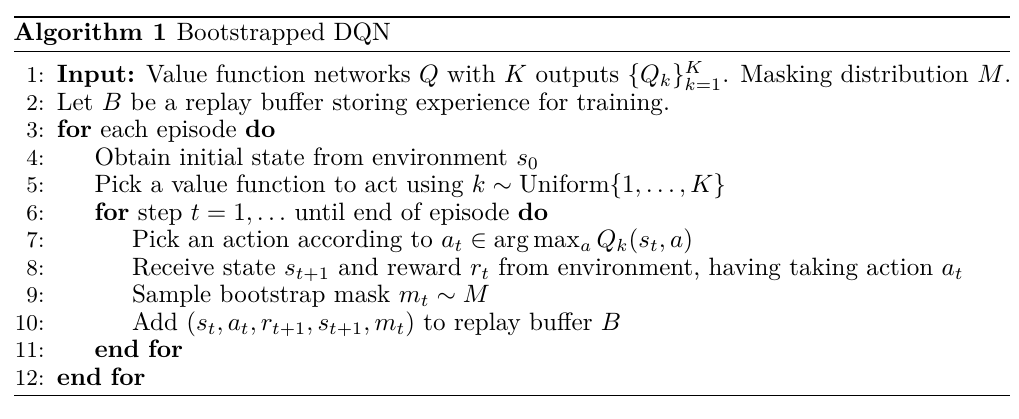

Gradient of the Kth Q network:
Deep Reinforcement Learning
Q-Learning Methods- Actor-Critic Methods
Actor-Critic Methods
- DDPG (Feb 2016)
- A3C (Jun 2016)
- UNREAL (Nov 2016)
- ACER (Nov 2016)
- The Reactor (Apr 2017)
- NoisyNet (Jun 2017)
Actor-Critic Methods
- DDPG (Feb 2016)
- A3C (Jun 2016)
- UNREAL (Nov 2016)
- ACER (Nov 2016)
- The Reactor (Apr 2017)
- NoisyNet (Jun 2017)
Deep Deterministic Policy Gradient (Feb 2016)
They proposed an actor-critic, model-free algorithm based on the deterministic policy gradient that can operate over continuous action spaces.

Deep Deterministic Policy Gradient (Feb 2016)


Critic loss:
Actor gradient:
critic estimates value of current policy by Q-learning
actor updates policy in direction that improves Q
Deep Deterministic Policy Gradient (Feb 2016)
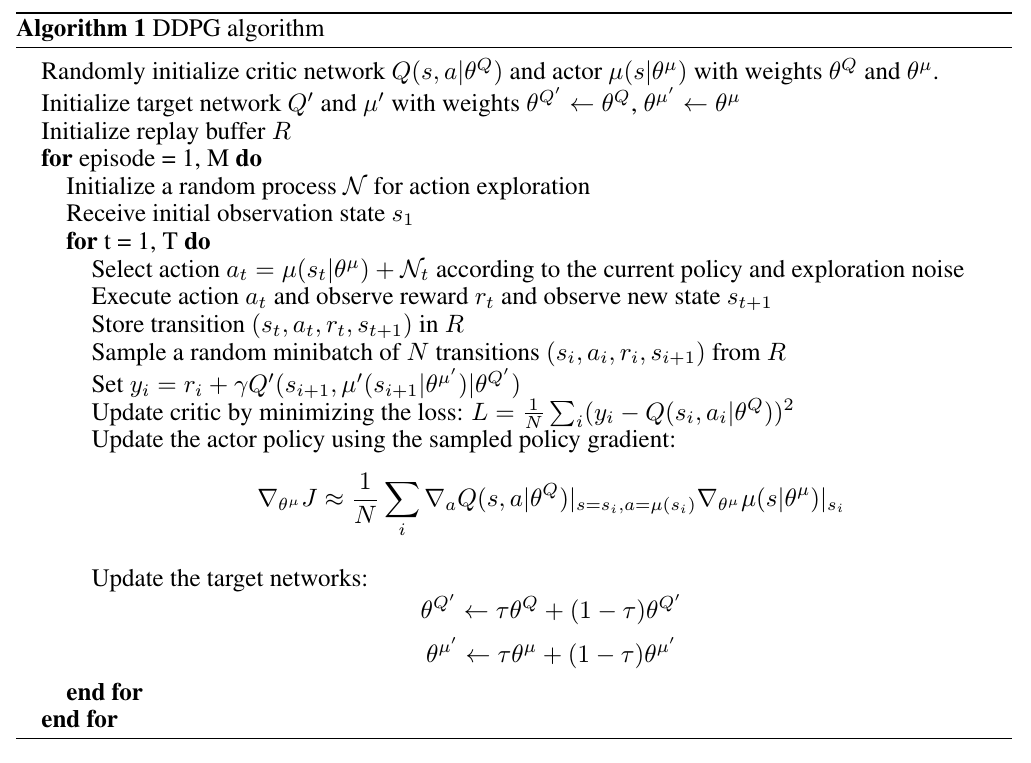
This part of gradient will be calculated from critic network by backpropagating into a
Deep Deterministic Policy Gradient (Feb 2016)
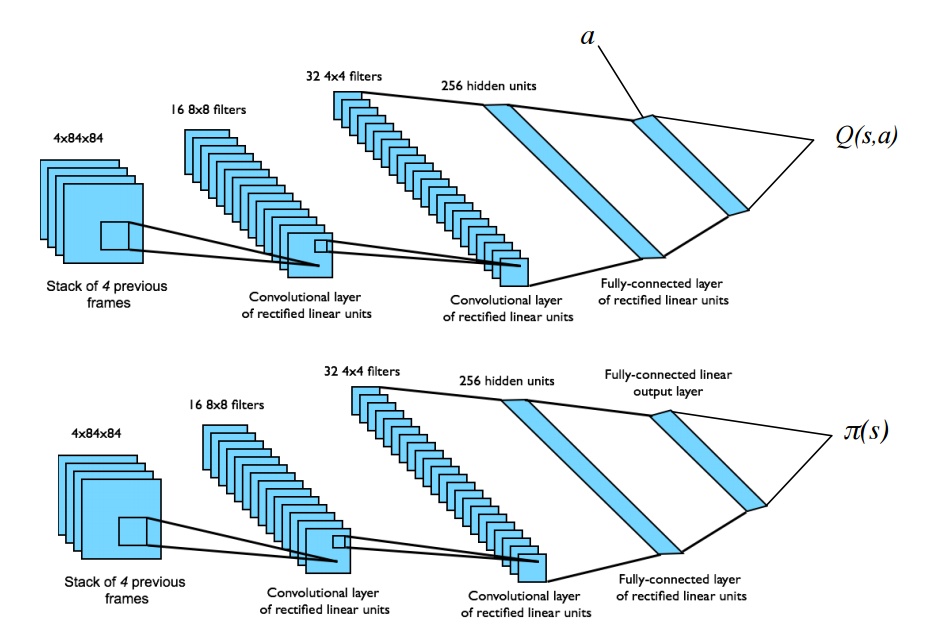
Actor-Critic Methods
DDPG (Feb 2016)- A3C (Jun 2016)
- UNREAL (Nov 2016)
- ACER (Nov 2016)
- The Reactor (Apr 2017)
- NoisyNet (Jun 2017)
Asynchronous advantage actor-critic (Jun 2016)
They proposed asynchronous variants of four standard reinforcement learning algorithms and showed that an asynchronous variant of actor-critic surpassed the state-of-art.
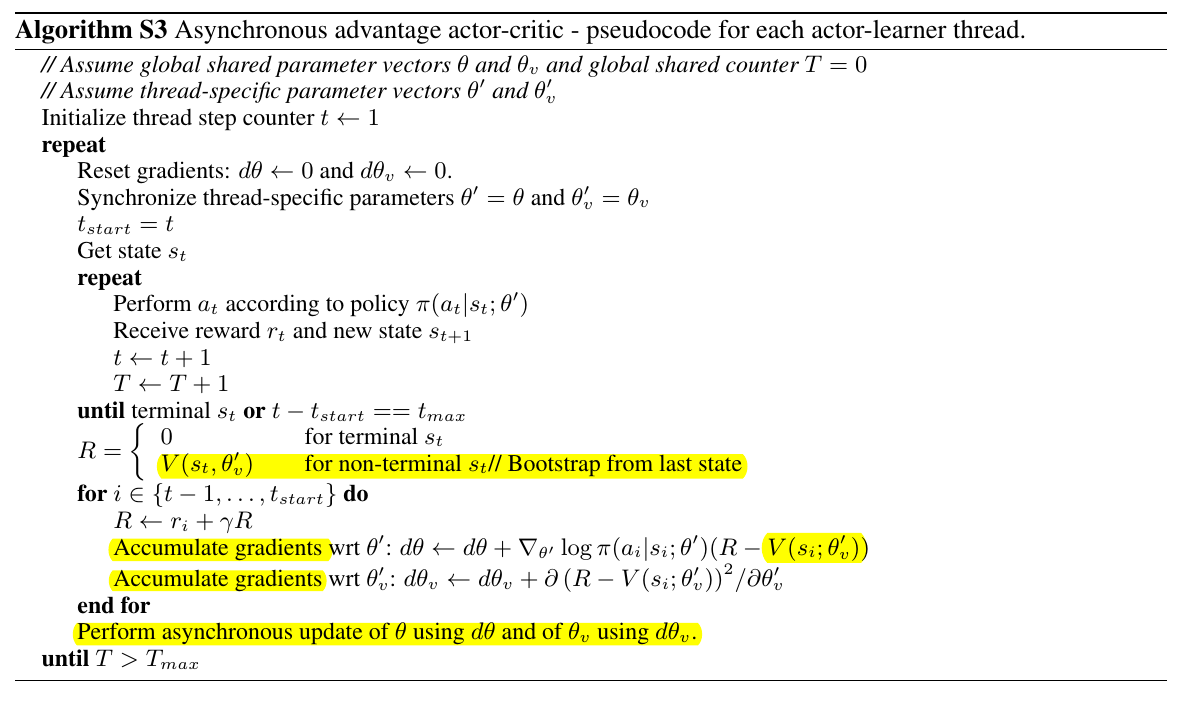
estimation of advantage
Actor-Critic Methods
DDPG (Feb 2016)-
A3C (Jun 2016) - UNREAL (Nov 2016)
- ACER (Nov 2016)
- The Reactor (Apr 2017)
- NoisyNet (Jun 2017)
Reinforcement learning with unsupervised auxiliary tasks (Nov 2016)
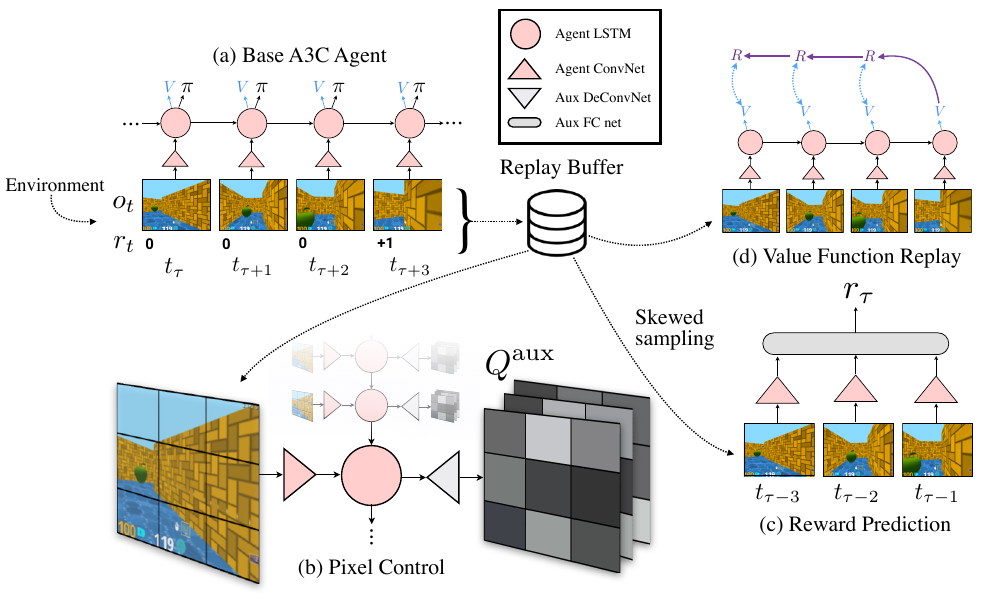
auxiliary control tasks
- pixel changes
- network features
auxiliary reward tasks
- reward prediction

Actor-Critic Methods
DDPG (Feb 2016)-
A3C (Jun 2016) UNREAL (Nov 2016)- ACER (Nov 2016)
- The Reactor (Apr 2017)
- NoisyNet (Jun 2017)
Sample efficient actor-critic with experience replay (Nov 2016)
This paper presents a stable actor-critic deep reinforcment learning method with experience replay by truncated importance sampling with bias correction, stochastic dueling network architecture and a new trust region policy optimization method.
The Reactor: a sample-efficient actor-critic architecture (Apr 2017)
The reactor is sample-efficient thanks to the use of memory replay, and numerical efficient since it uses multi-step returns.
Actor-Critic Methods
DDPG (Feb 2016)-
A3C (Jun 2016) UNREAL (Nov 2016)ACER (Nov 2016)The Reactor (Apr 2017)- NoisyNet (Jun 2017)
Noisy networks for exploration (Jun 2017)
Exploration
DQN - epsilon greedy
A3C - entropy loss over action space
NoisyNet- induce parametric noise by replacing the final linear layer in value network or policy network with noisy layer




noise random variables
Reference
- Mnih, Volodymyr, et al. "Human-level control through deep reinforcement learning." Nature 518.7540 (2015): 529-533.
- Van Hasselt, Hado, Arthur Guez, and David Silver. "Deep Reinforcement Learning with Double Q-Learning." AAAI. 2016.
- Schaul, Tom, et al. "Prioritized experience replay." arXiv preprint arXiv:1511.05952 (2015).
- Wang, Ziyu, et al. "Dueling network architectures for deep reinforcement learning." arXiv preprint arXiv:1511.06581 (2015).
- Osband, Ian, et al. "Deep exploration via bootstrapped DQN." Advances in Neural Information Processing Systems. 2016.
- Lillicrap, Timothy P., et al. "Continuous control with deep reinforcement learning." arXiv preprint arXiv:1509.02971 (2015).
- Mnih, Volodymyr, et al. "Asynchronous methods for deep reinforcement learning." International Conference on Machine Learning. 2016.
Reference
- Jaderberg, Max, et al. "Reinforcement learning with unsupervised auxiliary tasks." arXiv preprint arXiv:1611.05397 (2016).
- Wang, Ziyu, et al. "Sample efficient actor-critic with experience replay." arXiv preprint arXiv:1611.01224 (2016).
- Gruslys, Audrunas, et al. "The Reactor: A Sample-Efficient Actor-Critic Architecture." arXiv preprint arXiv:1704.04651 (2017).
- Fortunato, Meire, et al. "Noisy Networks for Exploration." arXiv preprint arXiv:1706.10295 (2017).
Thanks to Richard Sutton's book and David Silver's slides.
Thank you
deep reinforcemnt learning
By ligh1994
deep reinforcemnt learning
- 689


